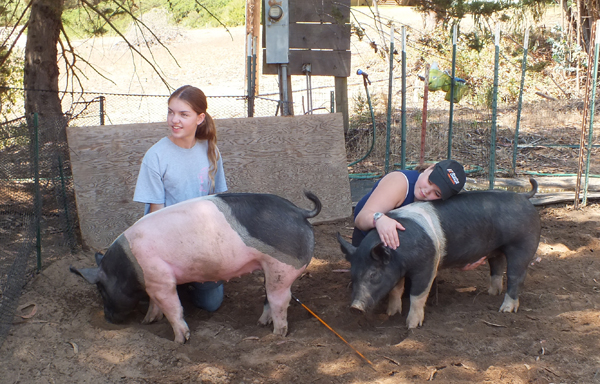4-H Sisters Ready Pigs for Livestock Auctions

Every morning Leesha Lopes and her younger sister Angela feed the six pigs they are raising, a pair for each of the three upcoming county fairs. Two have been set aside, as they are being fed an exact amount as they near their target weight for the upcoming Monterey County Fair.
Monterey’s fair, the first of the three county fairs, starts Aug. 29 and with two weeks to go, the Lopes sisters’ pigs are already beyond the low end of the target weight, 215 pounds, for the two pigs earmarked for it.
“They weigh 224 and 225 now,” Leesha, 16, said. “If you’re over 275 pounds you have to go home, so we measure their feed carefully.”
The Lopes sisters are like hundreds of 4-H kids, quilters, horticulturists, canners, bakers and probably even candlestick makers who are all making careful, final preparations for the county fairs, which celebrate the communities of Monterey Bay.
“A lot of people come to the fairs to see what their community’s talents are,” said Monterey County Fair CEO Kelly Violini. “With three fairs in basically a month, it’s like a triathlon for some.”
The Lopes sisters will enter in all three fairs. After Monterey’s ends on Sept. 3, the Santa Cruz County Fair runs Sept. 11-16 and then the San Benito County Fair will follow up on Sept. 28-30.
The Lopes sisters said each fair has its own charm.

Leesha (left) and Angela Lopes with some of the pigs they are raising for the three upcoming county fairs.
“Monterey has a bigger pig barn and wash racks, but Santa Cruz has a bigger shaded arena, which is really nice because you’re in there a long time,” Angela, 11, said. “There’s things I like about both fairs.”
This will be the first year the two, who both belong to Corralitos 4-H, will be showing at San Benito. With six pigs to show, the two spend at least an hour each morning and an hour each evening feeding, caring and training the pigs.
Gina Lopes, the girls’ mother, said 4-H has been great for her girls, teaching them responsibility and the value of work. The girls pay for the pigs’ care and feed, and then reap the profits at the end.
“It’s a good real life experience for them,” she said. “They take their projects very seriously.”
Angela said she wants to do something in animal science when she grows up. Leesha, who is closer to graduation, said she plans on becoming an occupational therapist. But now, the two are focused on their pigs. There is still much to do.
The two take their pigs to an arena and give them a workout. Tapping their sides and behinds with long sticks, they cajole the pigs to move around the dirt, constantly turning and moving.
“We’ll have to walk our pigs around the judge,” Angela said. “Whoever moves the pig the best, wins.”
“You have to keep the pig between you and judge,” Leesha explained further. “And we call it a ham sandwich, you and the judge are the bread and the pig is the ham.”
The knowledge that their pigs will be sold and eaten does not thrill the girls. Angela, with her arms around one of her pigs in an embrace, acknowledged it was tough.
“I just think of how they would go to commercial farms otherwise. I’ve been to a couple,” she said. “They don’t get individual attention. We take good care of them. They have a great life and then they go off. So they do have a great life this way.”
“We give them the best life they could possibly have,” Leesha said.
Just seconds after saying how much they like to work with their pigs, Angela’s pig pours a load of manure about two feet from where she is standing. She quickly grabs a rake and takes care of it.
“It’s just part of it,” she said. “You have to do the fun work and you have to do the dirty work,” she said.
